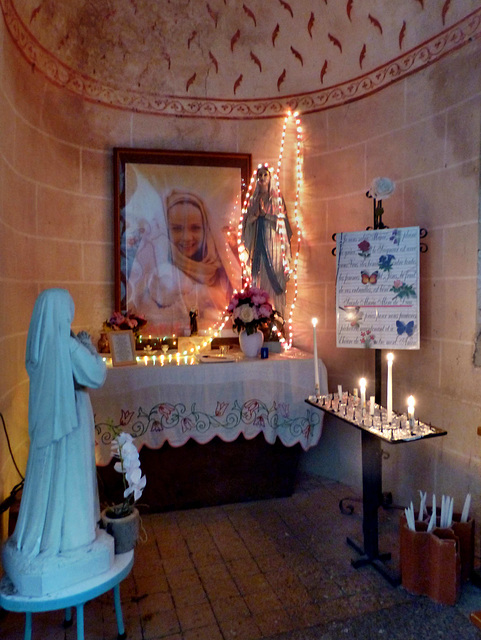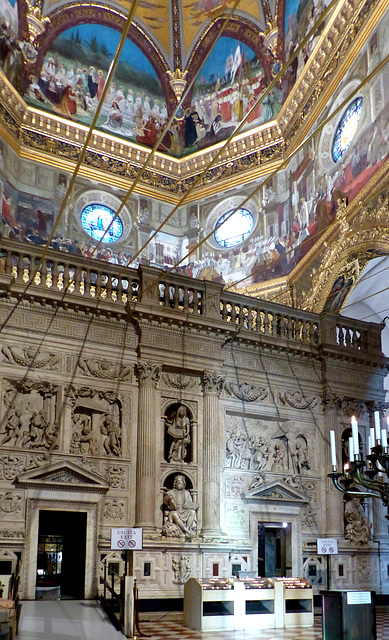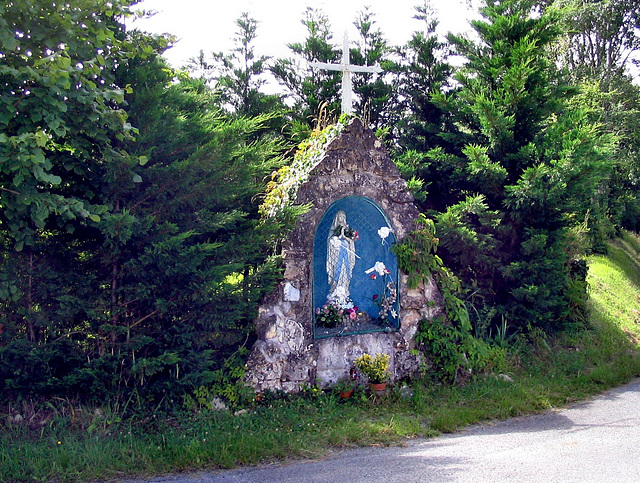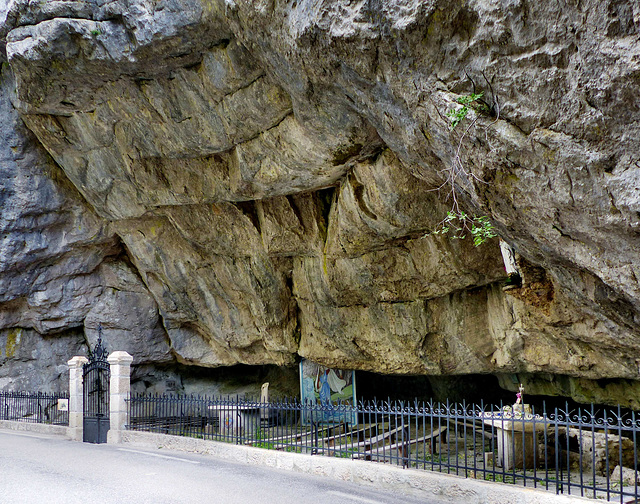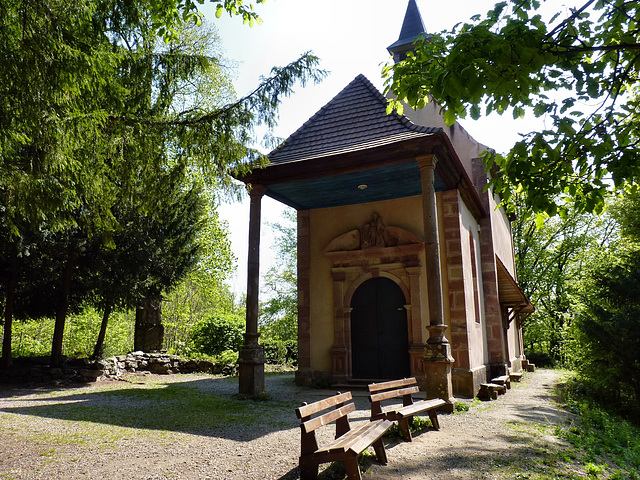
Lourdes, Loreto, La Salette
Lourdes, Loreto and La Salette are or have been important places of pilgrimage. Since not everyone made it there, there are replicas and chapels all over Europe.
Châtel-de-Neuvre - Saint-Laurent
Saint Laurent is located away from the village of Châtel-de-Neuvre. The church occupies the top of a hill overlooking the river Allier.
I learned, that the single-nave Romanesque church is one of the oldest in the department. It was built on or near the site of a Roman temple and some parts of this temple got even reused, when the church was erected.
Inside is a kind of "Lourdes grotto"-
Klasztor Benedyktynów w Mogilnie
The Benedictine monastery in Mogilno was founded by Casimir the Restorer in the 11th century. The monks most often came from the Rhineland and Bavaria. The construction of the church and monastery buildings began immediately after the arrival of the monks. The Mogilno Benedictines participated in spreading Christianity in Mazovia and Kujawy.
The old monastery buildings were rebuilt in the late Romanesque style, after their destruction in a conflict between the monks and prince Władysław Laskonogi. The hill, occupied by the Benedictines, was surrounded by a stone wall. In the 15th century, another reconstruction was made, which gave the monastery gothic features. In the following centuries, the political role of the monastery decreased. It was not until the 18th century that the Benedictine community began to flourish again and carried out a baroque reconstruction of the monastery complex,
In 1773 Mogilno came under Prussian rule, and the new authorities took over the monastery property, and in 1816 forbade the admission of novices. In 1833, the monastery was completely closed, and the buildings were given to local Catholics and Protestants. After 1880, the buildings housed a hospital, with the monastery church still serving as a parish. After Mogilno returned to Poland, the monastery housed a school and a shelter again, in 1934 it was renovated, and during WWII, the German Nazis established a transit camp, a prisoner-of-war camp, a prison for Jewish women, and a hospital.
In the garden, there is this Lourdes grotto.
Poznań - Kościół św. Jana Jerozolimskiego za murami
Long before the Christianization of Poland Poznań was an important cultural and political center of the Western Polans. It consisted of a fortified stronghold between the Warta and Cybina rivers. Mieszko I, the first historically recorded ruler of the West Polans and of the early Polish state which they dominated, built one of his main headquarters in Poznań. Mieszko's baptism in 966, seen as a defining moment in the Christianization of the Polish state, may have taken place in Poznań.
Following the baptism, construction began of Poznań's cathedral, the first in Poland. It became the place of burial of the early Piast monarchs, among them Mieszko I, Boleslaus I, Mieszko II Lambert, and Casimir I.
In 1038, Duke Bretislaus I of Bohemia sacked and destroyed both Poznań and Gniezno. In 1138, by the testament of Boleslaus III, Poland was divided into separate duchies under the late king's sons, and Poznań and its surroundings became the domain of Mieszko III the Old.
In 1249, Duke Przemysł I began constructing the Royal Castle on a hill on the left bank of the Warta. Then in 1253, Przemysł issued a charter for the founding of a town under Magdeburg law, between the castle and the river. A large number of German settlers were brought to aid in the building and settlement of the city, which was surrounded by a defensive wall, integrated with the castle.
Poznan was a major center for the fur trade by the late 16th century. Suburban settlements developed around the city walls, on the river islands, and on the right bank, however, the city's development was hampered by regular major fires and floods.
In the 17th century and the 18th, Poznań was affected by a series of wars, attendant military occupations, lootings, and destruction – the Northern Wars, the War of the Polish Succession, and the Seven Years' War. It was also hit by outbreaks of plague, and by floods, particularly that of 1736, which destroyed most of the suburban buildings. The population declined from 20,000 around 1600 to 6,000 around 1730, and Bambergian and Dutch settlers were brought in to rebuild the devastated suburbs.
In 1793, in the Second Partition of Poland, Poznań came under the control of the Kingdom of Prussia.
-
The original church on this site was built at the end of the 11th century outside Poznań's medieval defensive walls.
The church is dedicated to St. John of Jerusalem (John the Baptist), the patron saint of the Knights Hospitallers, to whom the church belonged until 1832.
According to Jan Długosz, in 1170 Mieszko III and the bishop of Poznań set up a pilgrims' hospice there. In 1187 the church and hospice were granted to the Order of the Knights Hospitallers. Around the beginning of the 13th century, the Order began construction of a new church, which is essentially the building that survives to this day. It was one of the first brick-built churches in Poland. At some point, the church was re-dedicated to the Order's patron saint,
Following damage in the late 15th century, the church was rebuilt in Gothic style. In 1736 a Baroque chapel was added on the south side. In 1832 the Prussian government abolished the Order, and the church became a parish church.
In the garden area by the church is this Lourdes statue.
Loreto - Basilica della Santa Casa
Loreto is commonly known as the seat of the Basilica della Santa Casa, a popular Catholic pilgrimage site for many centuries.
The story is a little complex. Since the early centuries of the Christian era, tradition claimed that the house of the Virgin was in Nazareth, where she was born, grew up, and where the announcement of the Archangel Gabriel took place. After the resurrection, the apostles would have gathered in this house and celebrated the Eucharist according to the teachings of Jesus
At the beginning of 1291 Nazareth was dominated by the Egyptian Mamluks. So some angels took the Santa Casa and carried it away. In May 1291, the angels left the house near the town of Fiume, where woodcutters found the small dwelling. However, in this place, the pilgrims were often victims of criminals. So, about three years later, the angels recaptured the Holy House and set out with it, and placed it near Ancona. The Holy House remained in this place for nine months, then the angels erected it again and placed it further south, in the village of Banderuola.
Shepherds who saw a bright light coming from the clouds and behind the light found the house. However, the place was too close to the sea and therefore exposed to the dangers of Turkish raid. Eight months later the house was again moved by the angels, this time to Monte Prodo on land belonging to Counts Stefano and Simone Rinaldi di Antici. The brothers soon benefited from the pilgrimages of the faithful to the point of petitioning the Pope, to become owners So again the angels raised the Holy House in flight and placed it at the end of 1296 in the middle of the road leading from Recanati to its port, and thus in a public place that no one could claim and exploit. The site chosen was the top of a hill covered with laurel. From the Latin word laurus the place was called Lauretum, that is Loreto.
The Casa Santa is located inside the shrine in the center of the church. It is about 9m long and 4m wide and has no foundation.
Today, it is argued that the crusaders may have brought the house to Italy. This is underlined by red cloth crosses of medieval crusader cloaks, which were walled between the stones of the house. Perhaps there is a connection with the Byzantine noble Angelos clan. Their name could have inspired the legend of the heavenly air transport.
Around the Casa Santa is a tall marble Renaissance screen designed by Bramante. The four sides represent the Annunciation, the Nativity, the Arrival of the Santa Casa at Loreto and the Nativity of the Virgin, respectively. I did not take photos inside.
Loreto - Basilica della Santa Casa
Loreto is commonly known as the seat of the Basilica della Santa Casa, a popular Catholic pilgrimage site for many centuries.
The story is a little complex. Since the early centuries of the Christian era, tradition claimed that the house of the Virgin was in Nazareth, where she was born, grew up, and where the announcement of the Archangel Gabriel took place. After the resurrection, the apostles would have gathered in this house and celebrated the Eucharist according to the teachings of Jesus
At the beginning of 1291 Nazareth was dominated by the Egyptian Mamluks. So some angels took the Santa Casa and carried it away. In May 1291, the angels left the house near the town of Fiume, where woodcutters found the small dwelling. However, in this place, the pilgrims were often victims of criminals. So, about three years later, the angels recaptured the Holy House and set out with it, and placed it near Ancona. The Holy House remained in this place for nine months, then the angels erected it again and placed it further south, in the village of Banderuola.
Shepherds who saw a bright light coming from the clouds and behind the light found the house. However, the place was too close to the sea and therefore exposed to the dangers of Turkish raid. Eight months later the house was again moved by the angels, this time to Monte Prodo on land belonging to Counts Stefano and Simone Rinaldi di Antici. The brothers soon benefited from the pilgrimages of the faithful to the point of petitioning the Pope, to become owners So again the angels raised the Holy House in flight and placed it at the end of 1296 in the middle of the road leading from Recanati to its port, and thus in a public place that no one could claim and exploit. The site chosen was the top of a hill covered with laurel. From the Latin word laurus the place was called Lauretum, that is Loreto.
The Casa Santa is located inside the shrine in the center of the church. It is about 9m long and 4m wide and has no foundation.
Today, it is argued that the crusaders may have brought the house to Italy. This is underlined by red cloth crosses of medieval crusader cloaks, which were walled between the stones of the house. Perhaps there is a connection with the Byzantine noble Angelos clan. Their name could have inspired the legend of the heavenly air transport.
Talking about air traffic: Our "Lady of Loreto" was declared the patron saint of aviation by Pope Benedict XV (1914-1922).
Lourdes
......Next to the grotto is a big area, where the candles can be lightened - and burn. They are so many, that they have built special metal huts with chimneys - just for the thousands of candles....
A Grotto
...the second half of the 19th century, this kind of Grottos were very fashionable in the catholic areas in Europe. A small "Lourdes" for every garden...
Saint-Auban - Notre Dame De La Clue
The Esteron river cut a very deep gorge into the mountain. Only a mule track existed, before the road through the gorge was constructed. In 1892, during the roadworks, a cave was discovered and converted into an oratory of Notre-Dame-de-Lourdes.
Murbach - Loreto Chapel
When I visited the Murbach abbey last year, I noticed a "Loretto Chapel" nearby. The chapel was placed on a hill, opposite the abbey, but I did not walk up to the chapel. Later I realized, that the by far best "photo-spot" of the abbey must be near the chapel. So when I returned, I walked up to the chapel.
Probably hundreds of Loretto Chapels still exist worldwide, all created after the original "casa santa", which is inside the basilica in Loreto, Italy.
This "Holy House" is a major place of pilgrimage since the 14th century, as it was believed, that this was the house, where Mary was born and brought up.
Legends tell, that angels carried the house through the air from Nazareth to Italy (with a little stopover in Croatia). Historians could trace the "casa santa" back to the time of the cruisades - and even found out, that a family with the family name "Angeli" is connected to the early times of the shrine.
Sitting on the benches seen here, you´ll have a breathtaking view - and immidiatly prepare your camera...
Jump to top
RSS feed- Latest items - Subscribe to the latest items added to this album
- ipernity © 2007-2024
- Help & Contact
|
Club news
|
About ipernity
|
History |
ipernity Club & Prices |
Guide of good conduct
Donate | Group guidelines | Privacy policy | Terms of use | Statutes | In memoria -
Facebook
Twitter

